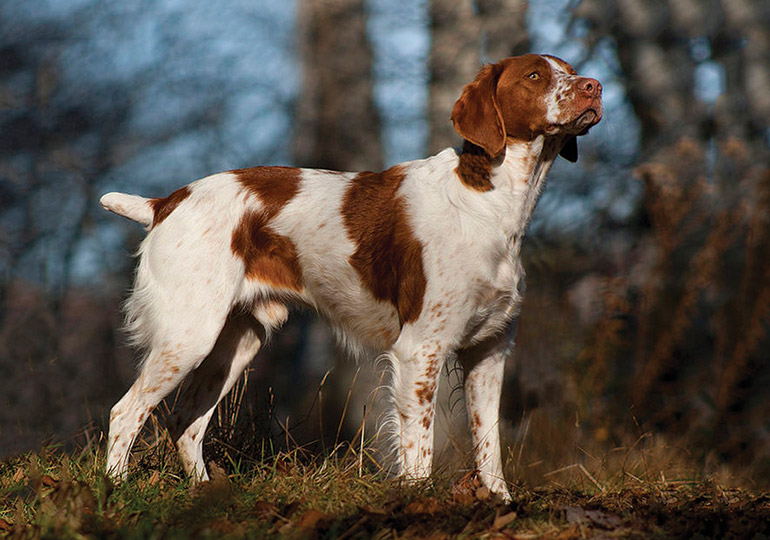
GROUP 3 - GUNDOGS
The Brittany derives its name from the region of Brittany in France, where it evolved around the 1850s as a result of initially crossing local French Spaniels with Setters, and then crossing the offspring with French Braques, a tailless pointing breed.
These original Brittanys were either short-tailed, or without tails, and were originally bred by the peasants of Brittany to hunt game and do other things around the house, such as catch vermin. The upper classes recognised the value of such talents and eventually started to own and breed their own Brittanys.
Officially recognised in France in 1907, it was not until 1978 that they were first imported to Australia. They remain a rare breed among the Gundogs but are increasing in popularity.
Originally called Brittany Spaniels, the name was shortened to Brittany in 1998 in Australia. The change is justified in that Spaniels mainly flush game, whereas the Brittany is a utility Gundog and not a true Spaniel. It hunts, points and retrieves.
In the field, the Brittany is generally used on game birds and small game and has a remarkable passion for hunting. Great stamina and a fantastic nose, combined with high intelligence and natural instinct, make it an ideal Gundog.
Most Australian Brittanys come from North American lines, where breeders have been careful to preserve the breed as a dual purpose dog, which means there is no difference between field trial dogs and conformation show dogs. Brittanys can leave the field one day, be bathed and groomed, and win a conformation show the next day.
However, for those who are not interested in hunting but still want an active, athletic dog, the Brittany easily adapts to life with a family. It is a superb family pet, loyal and faithful at all times, friendly to both people and other dogs.
It does require regular exercise and mental stimulation and this is particularly important if it is kept in a backyard. Without regular exercise, the Brittany will become bored and destructive.
The Brittany is a breed with an outgoing personality. With their high intelligence they can turn on the charm to get their way.
They bond very easily to all members of the family and are not ‘one person’ dogs. They are probably too active for very young children, but are willing and patient playmates to older children.
Brittanys cannot be regarded as guard dogs but they can be protective of the family and will let you know if someone enters the property. That said, they will generally meet visitors with a lot of tail- wagging and goodwill.
In Australia, the Brittany has orange and white or liver and white markings. It is one of the smallest of the Gundog breeds and has an elegant, leggy outline, where the length of the dog is equal to its height at the shoulders. In other words, the body should fit into a square. It is compact and muscular but not overly heavy.
The head of a Brittany is wedge-shaped, with the eyes showing an intelligent and gentle expression.
The ears are set high, above the level of the eye, and sit close to the cheek. They are short and very expressive, giving the dog an alert expression.
The coat is short and either flat or slightly wavy. There is feathering on the back of the limbs and on the belly. There are breeding lines of Brittanys in Australia that produce puppies with naturally short tails.
The Brittany coat sheds dirt easily, but still requires regular brushing and combing to keep it in good condition. It should be washed when necessary. There is a minimal amount of coat shedding with the breed, which is a real advantage.
While clipping and trimming of the coat is not necessary, the Brittany’s looks are improved with the fringe around the ears being trimmed, and the fur on the feet trimmed when the nails are clipped.
The Brittany is generally a healthy breed. Breeders today make sure their breeding stock are at least hip and elbow x-rayed and eye tested prior to breeding.
The breed generally doesn’t have hereditary health problems because of its natural and efficient conformation, and a healthy dog will live for approximately 13 years.
The Brittany is a medium-sized dog with the ideal height for males being 48-51cm and weight between 15-17kg. The female’s ideal height is 46-48cm and weight between 13-15kg.
The breed represents a good alternative for people who like the attributes of a Gundog, but find other Gundog breeds too large. They can also be transported easily in the family car and they fit into the household routine easily.
It must be remembered, however, that they are a hunting breed and need mental and physical stimulation every day. A Brittany will enjoy sitting on your lap, but they are ready for the great outdoors at any time.
In Australia, the Brittany is making its mark in Agility, Tracking and Obedience trials, so there are plenty of options for owners to participate in activities that involve them and their dogs.
Words: Peter Marsh
Image: petcollectionworld
Now you know a little about the Brittany, you may think that this is the dog for you. Before you make a decision, please make contact with the breed club or your State controlling body for purebred dogs. They will be able to give you information about available puppies and also suggest dog shows where you can see the breed and speak to breeders. In this way you will gain a better perspective of the Brittany and its needs, and whether this breed would suit your lifestyle.